India’s First Vertical Lift Sea Bridge: Pamban Bridge, a ‘Make in India’ Marvel
Hello Questers
Hope you're all doing well! If you're working hard on something, keep pushing forward. In this thread, I want to share an incredible milestone achieved by Indian engineers, the Indian Railways, and Dalmia Cement. It’s all about the Pamban Bridge India’s first vertical lift sea bridge! Here's a glimpse into this historic engineering marvel.

The New Pamban Railway Bridge in Tamil Nadu, a remarkable feat of modern engineering, is set to enhance the connectivity between Mandapam and Rameswaram Island.
This cutting-edge structure replaces the 110-year-old Pamban Bridge, which was a vital link built during British rule. The older bridge, though iconic, had become increasingly difficult to maintain due to sea breeze-induced corrosion and other wear and tear, causing frequent disruptions to rail traffic. The construction of the new bridge began in 2019, with the aim of creating a more robust and reliable link for pilgrims and tourists visiting Rameswaram, a place of immense religious significance tied to the Ramayana.
Key Features and Modern Advances of the New Pamban Railway Bridge:
1. Vertical Lift Mechanism:
The New Pamban Bridge holds the distinction of being India's first vertical lift sea bridge. This advanced feature allows for the central span of the bridge to be raised up to 17 meters to facilitate the uninterrupted passage of large ships and vessels beneath. The vertical lift span is 72.5 meters high and is controlled by a fully automated electro-mechanical system that ensures precision in lifting and lowering the bridge.
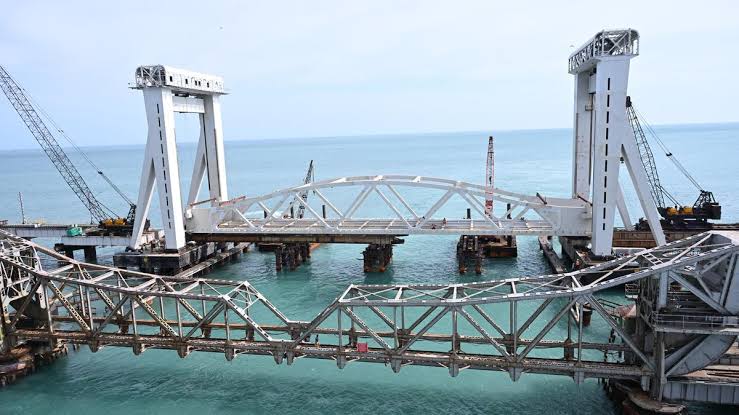
2. Enhanced Length and Structure:
Spanning 2.08 kilometers (6,790 feet), the new bridge stretches across the sea, making it a spectacular sight. It is designed with 100 arches to provide additional structural stability. Of these, 99 arches stand at a height of 18.3 meters, with the central vertical lift span forming the 100th arch. The entire bridge is designed to withstand the harsh maritime environment and minimize the impact of the sea breeze, which caused significant wear to the old bridge.

3. Speed and Capacity Upgrades:
The old Pamban Bridge imposed speed restrictions on trains due to its age and structural limitations, with trains crossing at just 10 km/h. The new bridge, however, is designed to support higher speeds, significantly improving travel times. Additionally, the foundation of the new bridge is structured to accommodate a future double-track system, ensuring that the bridge can handle increased rail traffic as tourism and pilgrimage demand grow.
4. Modern Construction and Materials:
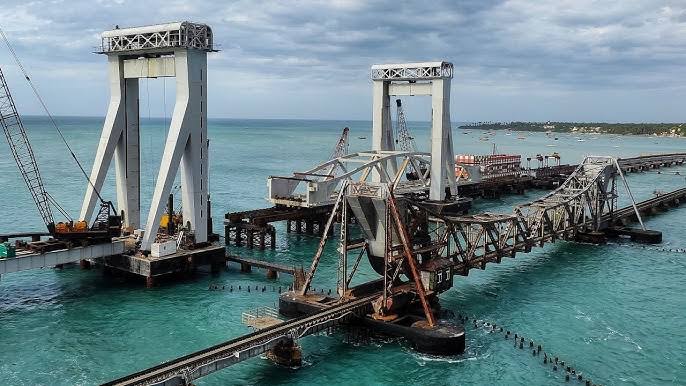
All materials used in the bridge’s construction have been sourced from a dedicated workshop at Chatrakudi near Ramanathapuram. The bridge has been developed under the guidance of the Railway Research Designs and Standards Organization (RDSO) to ensure that it meets the highest safety and durability standards. The use of high-quality, corrosion-resistant materials ensures a longer lifespan with reduced maintenance needs compared to its predecessor.
5. Strategic Importance for Pilgrimage and Tourism:
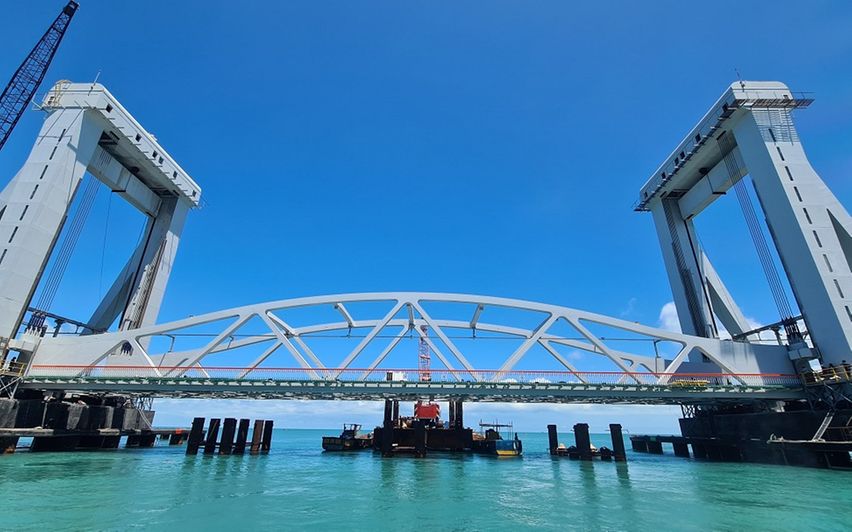
Rameswaram, one of the holiest cities in India, is visited by thousands of pilgrims and tourists each year who come to see the Ramanathaswamy Temple, Dhanushkodi, Kothandaram Temple, and Ramapadam (Rama’s Foot). The new bridge will enhance access to these important sites by providing a seamless and reliable transportation option. The scenic experience of traveling by train across the open sea will continue to be a major attraction for visitors.
6. Cost and Timeline:
The project, which began in 2019, is expected to cost approximately ₹550 crore upon completion. The bridge's construction has progressed rapidly, and it is now in its final stages. Trial runs are currently underway, and the Indian Railways has indicated that the bridge will be open to rail traffic in the coming weeks.
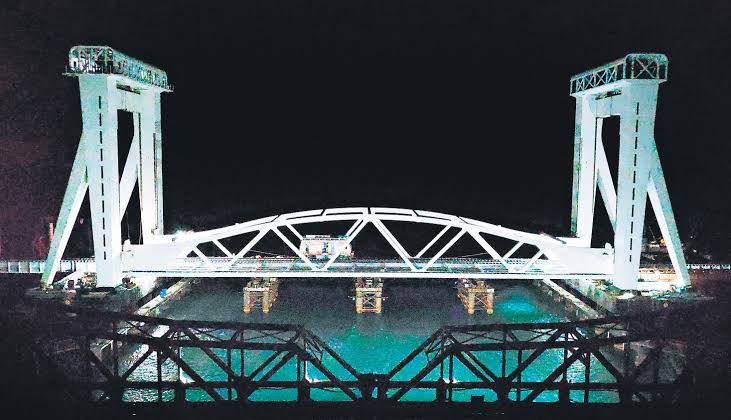
Importance of the New Bridge:
The New Pamban Railway Bridge is not just an engineering marvel but also a symbol of India’s infrastructural progress. It is designed to significantly improve the reliability of rail services to Rameswaram, which had been frequently interrupted due to maintenance issues with the old bridge.
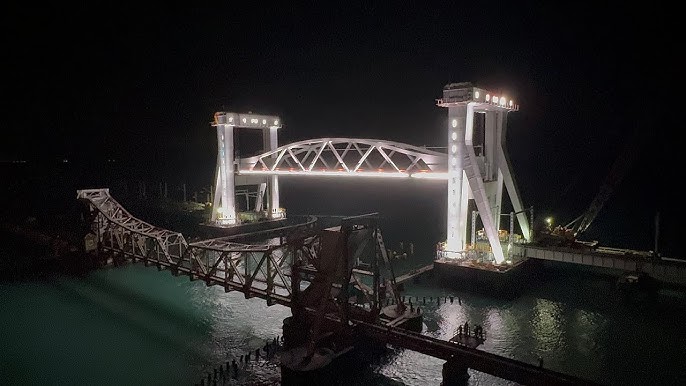
Moreover, the new structure is poised to handle the increasing volume of tourists and pilgrims, while also promoting economic development in the region through improved transport connectivity. The bridge will also play a crucial role in ensuring the continued flow of both passenger and freight traffic across the narrow Pamban Strait.
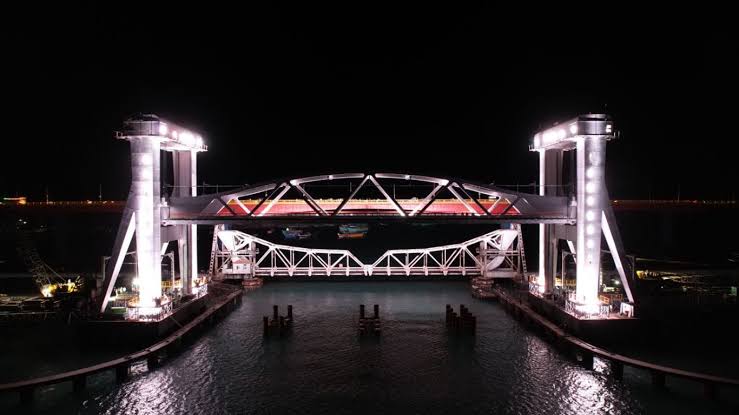
In summary, the New Pamban Bridge blends modern technology with heritage, ensuring that visitors continue to enjoy the breathtaking experience of a train journey across the sea while benefiting from a safer, faster, and more efficient transportation system.
PC:Google Images
Signing Off
Your Superb Qool Quester 😎
iQOO Ranger
Official Community
Thread/Post No:458
Please sign in
Login and share

























